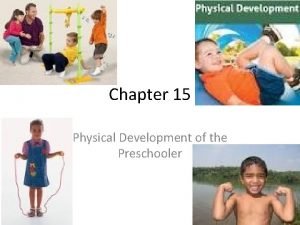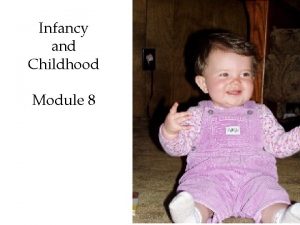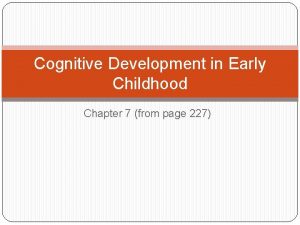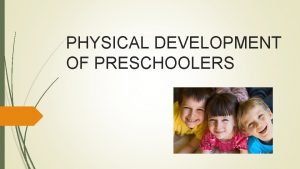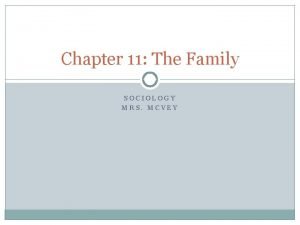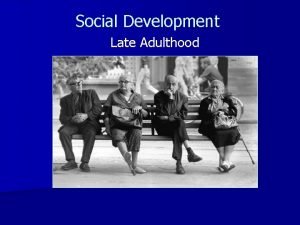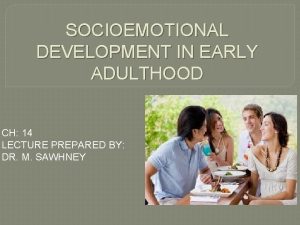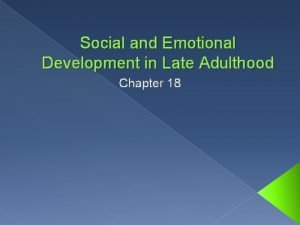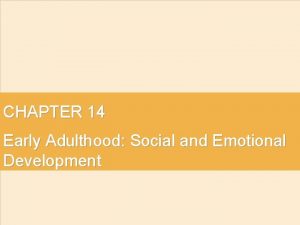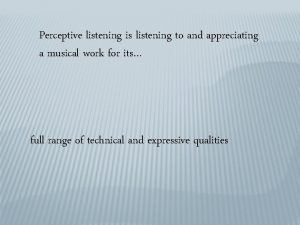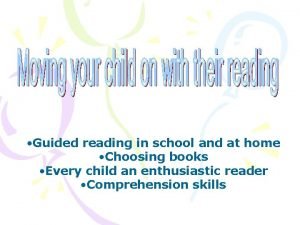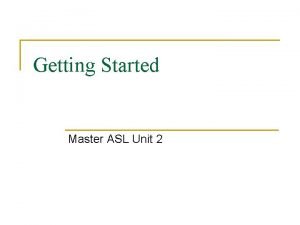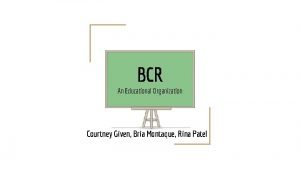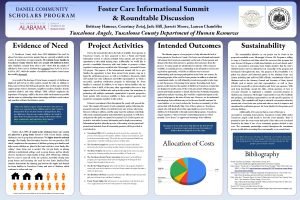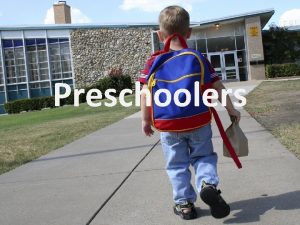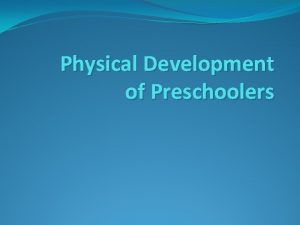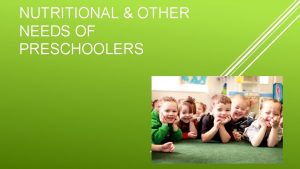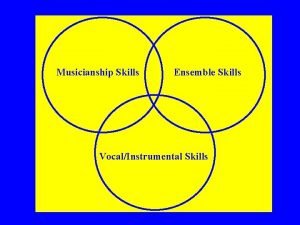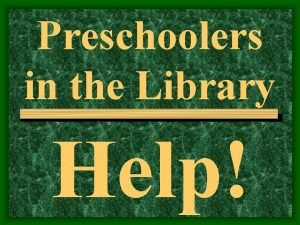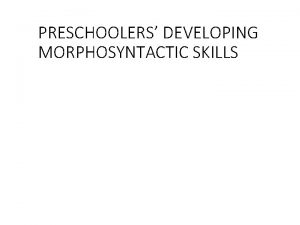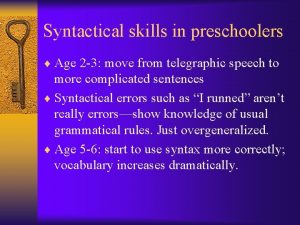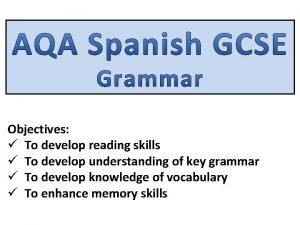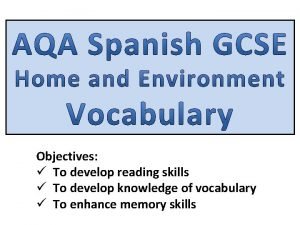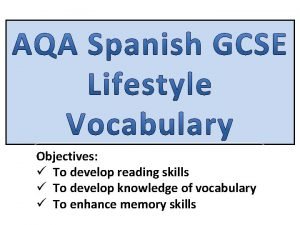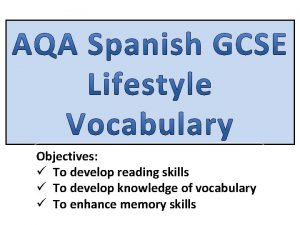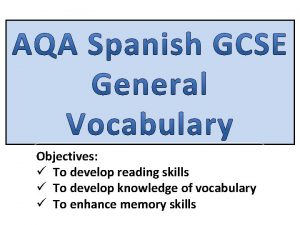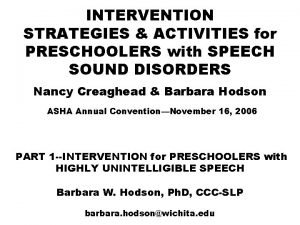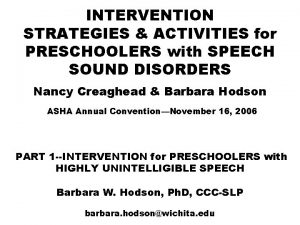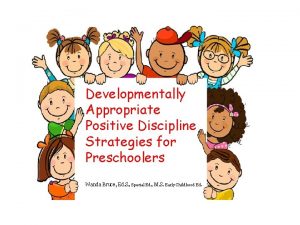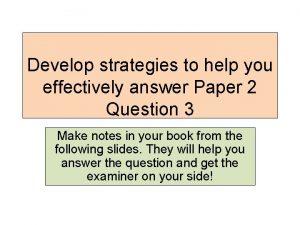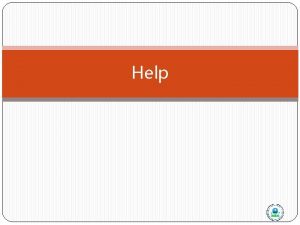Strategies to Help Preschoolers Develop Socioemotional Skills Courtney





























- Slides: 29

Strategies to Help Preschoolers Develop Socioemotional Skills Courtney N. Baker, Ph. D. Re. NEW Early Childhood Programs Friday, August 23 rd, 2016


Roadmap • SEL and Early Childhood Development • Teaching SEL – Direct instruction – Provide a classroom environment that fosters SEL • Strategies to Teach SEL – SEL curriculum – Classroom behavior management • Project Pre-K TIPS Research Study

Socioemotional Learning (SEL) Social and emotional learning (SEL) is the process through which children and adults acquire and effectively apply the knowledge, attitudes, and skills necessary to understand manage emotions, set and achieve positive goals, feel and show empathy for others, establish and maintain positive relationships, and make responsible decisions. CASEL, 2015

Socioemotional Learning (SEL) CASEL, 2015

Socioemotional Learning (SEL) CASEL, 2015

Research on SEL • Better academic performance: achievement scores an average of 11 percentile points higher than students who did not receive SEL instruction; • Improved attitudes and behaviors: greater motivation to learn, deeper commitment to school, increased time devoted to schoolwork, and better classroom behavior; • Fewer negative behaviors: decreased disruptive class behavior, noncompliance, aggression, delinquent acts, and disciplinary referrals; and • Reduced emotional distress: fewer reports of student depression, anxiety, stress, and social withdrawal. CASEL, 2015; Durlak et al. , 2011

SEL and Early Childhood Development

Teaching SEL • Teaching social and emotional skills directly – Curriculum and instruction • Provide a classroom environment that fosters SEL – Safe and predictable – Emotionally supportive and responsive – Use of positive discipline practices

g n i ss ce c A s o t ice s er erv i r S ar Im ple Insu me ffic nta ient tio n( Do se) B Lo w f o n Qu a lit y Im o i t ra ple m en ta tio n Ina d e d i s n o xt C te onte a u C eq

s e c vi sy a E Hi gh Qu Suf me ficie nta nt tio n( Do se) ple s cce A o -t er S s Im ali f o n ty Im o i t ra ple m en ta tio n Th o e d i s n Co text l u on f t h C ug

Direct Instruction in SEL

Direct Instruction in SEL • How? – Teach • Curriculum guide • Lesson materials – Generalize • Tips to integrate into daily classroom activities • Help spotting natural times to support children’s practice of SEL skills • Parent handout and “homework” – Maintain • Building an SEL classroom, one lesson at a time

SEL Curriculum Topics • Feelings identification and vocabulary • Managing strong feelings – Deep breathing – Take a break – Coping self-talk – Tucker the Turtle technique • Identifying feelings in others and empathy • Being a good friend • Problem solving

Fostering SEL in the Classroom • Create a safe and predicable environment – Clear class rules – Clear commands – Routines for attention and transitions • Create an emotionally supportive and responsive classroom – 4: 1 positive: negative interactions; 1 positive interaction per child every 5 minutes – Behavior-specific praise • Use of positive discipline practices – Planned ignoring – Concise, informative reprimand

Class Rules • • • Age-appropriate Specific and observable Stated positively Easy to understand Enforceable 3 -5 rules total Reinke et al. , 2012

Commands • • Get the child’s attention Clear and simple Enforceable One at a time

Routines • Routine for getting students’ attention and transitions – Explicitly teach routine – Preteach (transition only) – Reward successes – Examples • Hand up for quiet attention • 5 and 1 minute warning for clean up and transition

Positive Interactions • 4: 1 positive to negative interactions – Notice rule-following behaviors • At least 1 positive interaction per student every 5 minutes • Examples – Praise, warm tone, high five, smile, personal comment about child, engaging instruction, eye contact – Noticing the times when everyone, even children with lots of disruptive behavior, are following the rules

Behavior-Specific Praise • Why? – Positive reinforcement • Specific praise or praise that includes a description of the behavior being praised • Examples – “Good job finishing your math worksheet. ” – “Thank you for raising your hand. ” – “Everyone has their eyes on me. Good. ” Reinke et al. , 2012

Planned Ignoring • Why? – Positive reinforcement • Ignore minor misbehavior • And then attend to and reward rule-following behaviors • Examples – During clean up time, ignore child tapping blocks on floor instead of cleaning – Attend the second the child begins to clean up and praise “Great job cleaning up those blocks!”

Concise, Informative Reprimand • Verbal comments or gestures by teacher to indicate disapproval of behavior – – – Brief Normal speaking tone Direct attention to the rule that was violated Indicate what the behavior should be And then attend to and reward rule-following behavior • Examples – “China, please have a seat” (when China gets out of her seat) – “I am talking, eyes on me” (when a group of children are talking) – Finger to lips when students are talking Reinke et al. , 2012

Video Example • http: //www. youtube. com/watch? v=g 0 Hu. LG 6 M_Y

Project Pre-K TIPS • Goal: To evaluate whether Project DIRECT’s coaching model… – Is feasible and acceptable to teachers – Helps children develop socioemotional skills Funded by the Louisiana Board of Regents

Project Pre-K TIPS • Activities – PD Training on SEL – Weekly coaching throughout the school year (~21 weeks) – Support for challenging behaviors in the classroom

Project Pre-K TIPS • Research Study – Comparing two types of coaching – Random assignment • Evaluation Plan

Project Pre-K TIPS • Being part of a research study – Privacy and confidentiality, your information will not be shared with anyone at your job – Voluntary, whether you decide to participate or not will not affect your job – Opportunity to contribute to knowledge about SEL

Project Pre-K TIPS • Timeline – PD Training (Today) – Recruitment and Consenting (~8/29 -9/16) • Teachers • Students (Parents) – Classroom incentive – Pretest Data Collection (~9/19 -10/21) – Coaching (~10/24 -4/14) – Posttest Data Collection (~4/17 -5/12)

Thank you!
 Module 15 preschoolers physical development
Module 15 preschoolers physical development Preschoolers often have trouble buttoning shirts
Preschoolers often have trouble buttoning shirts Preschoolers seem to use illogical reasoning
Preschoolers seem to use illogical reasoning Physical growth of preschoolers
Physical growth of preschoolers It is a self portrait composed of many pieces
It is a self portrait composed of many pieces Socioemotional maintenance definition
Socioemotional maintenance definition Emotional changes in middle adulthood
Emotional changes in middle adulthood Socioemotional development in infancy
Socioemotional development in infancy Middle and late childhood symbol
Middle and late childhood symbol Socioemotional selectivity theory
Socioemotional selectivity theory Emotional development in late adulthood
Emotional development in late adulthood Socioemotional development in early adulthood
Socioemotional development in early adulthood Elders' housing preferences reflect a strong desire for
Elders' housing preferences reflect a strong desire for Emotional development during early adulthood
Emotional development during early adulthood What word refers to the way sounds are woven together?
What word refers to the way sounds are woven together? Interpersonal skills business
Interpersonal skills business How to develop reading skills in students
How to develop reading skills in students Developing effective reading skills
Developing effective reading skills Spagetti poem
Spagetti poem Im being oppressed
Im being oppressed N
N Becoming a helper 7th edition
Becoming a helper 7th edition Education through self help is our motto
Education through self help is our motto Freesurfer troubleshooting
Freesurfer troubleshooting Courtney bass mediator
Courtney bass mediator Courtney given
Courtney given Courtney medeiros
Courtney medeiros Courtney medeiros
Courtney medeiros Courtney zotaj
Courtney zotaj Dr courtney mapes
Dr courtney mapes
